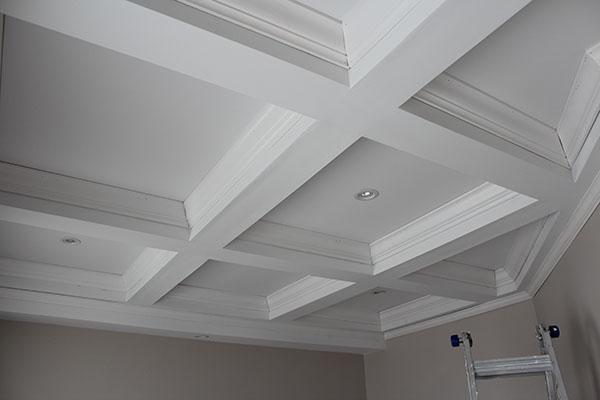
I’m relieved to finally tell you that all of the crown molding has been installed in our home office. It was a bear. Granted, I still have to putty all the nail holes, caulk the joints and paint them. I’ll save that work for the weekend. That’s not the end of the molding in the office either. Once the built-ins are completed and installed, I still have to install a final piece of wall trim and all the baseboard molding. However, that type of trim work should be considerably easier to handle.
In today’s post, I’m sharing a video tutorial I made (with Lisa as camera lady) as well as some additional info below where I discuss some of the techniques I used to get better crown molding results.
Tips for Better Crown Molding Results
1. Pre-paint your Molding. While not hugely important, getting at least one good coat of paint on the molding BEFORE you install it will allow you to only have to paint it one more time after it’s installed. That’s less time on the ladder.
2. Use Backer Blocks. In the video, I use some simple plywood backer blocks. These little blocks can be cut from scrap wood and provide the crown molding a solid surface to lay against. It makes installation SO MUCH EASIER. After this list, I’ve shared a quick tutorial on making your own backer blocks.
3. Make a Cut Guide. Before measuring and cutting any intersecting crown molding pieces, make a cut guide with a piece of scrap crown molding. The guide can have a 45 degree cut on both ends and can be used to determine if any adjustments need to be made before the actual piece is cut. You’d rather find out that your molding needs a slight adjustment before you cut through it.
4. Use a Crown Molding Jig. While I do recommend using the Bench Dog Crown Molding Jig (affiliate link), you can just as easily make your own using some scrap lumber and a couple of clamps.
5. Be Strategic with your Boards. When you walk by the office or look inside, all of the crown molding pieces that face you don’t have any miter cuts. They all are straight pieces. That’s intentional. All of the cut boards are on the sides of the boxes. That way, even if the joints aren’t perfect, almost no one will notice if they stick their head in the room. Getting the joints done right is important, but any minor mistakes will be less visible this way.
How to Make Backer Blocks for Crown Molding
1. You’ll need a carpenter’s square, a small piece of the crown molding, a paper, and a pen.
2. Arrange the crown molding inside the carpenter’s square so that both the top and bottom flats of the molding are flat against the square. This is how the crown molding will look when installed.
3. Using a pen or a pencil, trace the inside triangle made by the molding and the square.
4. You can remove the square and the molding.
5. Measure the length of the top and the length of the side, marked here as “A” and “B,” respectively.
6. Now for some math. Using a scientific calculator or an online calculator take the inverse tangent (tan raised to the -1) of A over B (A/B). If you do that math, you get 38.7 degrees or roughly 39 degrees. Now you can set your table saw angle to that value. All you need to do now is make sure you cut the board to the length of “A,” which in this case is 1″.
To make things easier on you, you can also lay that drawing on your miter saw and use the miter saw’s gauge to determine the angle of the molding. OR you can just use a protractor.
For our home office, the larger molding had a block with an angle of 36 degrees and as mentioned above, the smaller molding was 39 degrees.
I hope you found this post helpful. Even if you’re not planning any crown molding work, keep this project in mind for when you do.
Now I’d like to hear from you. Do you have any crown molding installation tips or tricks?